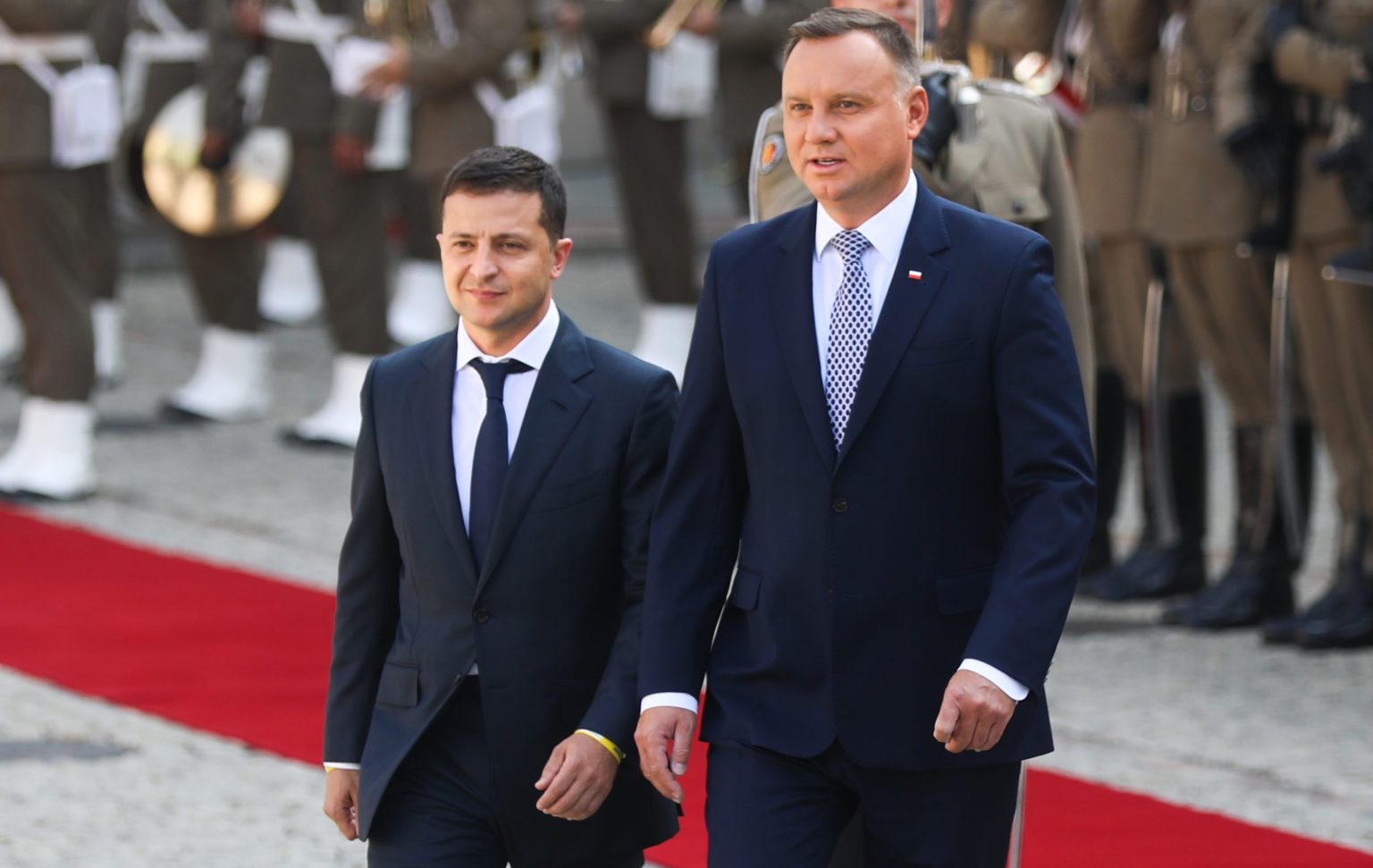Source: The American Conservative
The Threat Of Polish Involvement In Ukraine
The war against Russia in Ukraine has evolved, but not in the way Western observers predicted.
Ukrainian President Volodymyr Zelensky visits Polish President Andrzej Duda at the Presidential Palace on August 31, 2019 in Warsaw, Poland. (Photo by Beata Zawrzel/NurPhoto via Getty Images)
May 10, 2022 | By Douglas MacGregor
"In economics," wrote John Kenneth Galbraith, "the majority is always wrong." Galbraith might have added that in military affairs, there is a mountain of historical evidence to suggest that American generals and military analysts are always wrong, too.When the Spanish Civil War ended in March 1939 after three years of brutal fighting that saw Soviet, German, and Italian equipment, advisors, and troops in heavy combat, senior military leaders in London, Paris, and Washington found surprisingly little evidence to suggest a profound change in warfare. In fact, a U.S. Army officer who later became a major general witnessed the fighting and suggested that, "In Spain, the theories proclaimed for the devastating power of Panzer divisions and other massed armored formations used 'independently' are apparently refuted by actual events." Five months later, events in Poland would repudiate these words, but at the time, his views were widely shared in the West.
The war against Russia in Ukraine is different from the Spanish Civil War. It's a proxy war designed to employ the full range of American and allied capabilities against Russia in Ukraine. If Americans are beginning to wonder whether Washington's enormous investment in Ukrainian assistance has colored the opinions of U.S. analysts and their evaluation of events in Ukraine, their suspicions are justified.
Within days of the war's outbreak, President Biden signed off on an emergency spending package that included $13 billion in aid to Ukraine, half of which was allocated for military purposes. Combined with the recently promised $33 billion in additional military assistance to Ukraine, the total cost of U.S. taxpayer-funded military assistance to Ukraine in 2022 approaches the Russian army's annual budget. Perhaps most important, in Ukraine, U.S. advisors provide intelligence and targeting guidance along with the rapid resupply of critical war-fighting equipment.
As the fighting raged in Ukraine, as if on cue, retired U.S. Army generals appeared on television to herald an imminent Ukrainian victory based on the country's allegedly spectacular battlefield successes and Russia's extraordinary incompetence. Russian forces, they argued, were doomed to defeat by serious tactical errors, logistical shortfalls, and weak execution. In retrospect, some of these comments involved "mirror imaging," but much of the criticism almost certainly reflected the sunk costs of U.S. investment in Ukrainian military capability.
It did not take long for American analysts to insist that the Russian military leadership had made the unpardonable mistake of not "front-loading" the Russian offensive in Ukraine with strikes from precision guided missiles, Desert Storm-style. American military pundits and their British colleagues were also quick to pass judgement on the failure of Russian ground forces to race west along two or three major axes. If Ukrainian forces could inflict enough human and equipment losses on Russian forces, the narrative went, Moscow would abandon its objectives and withdraw its forces. Of course, expecting the Russians to suspend operations on such spurious grounds makes about as much sense as expecting Washington to sue for peace after Pearl Harbor.
The retired generals paid little attention to the operational situation. Contrary to the picture painted by Western analysts, Russian ground forces pressed forward, moving methodically along a 300-mile front to identify and selectively attack Ukrainian forces.
Few analysts in the West knew or cared that Russian commanders were instructed to avoid collateral damage to the civilian population and infrastructure. Initially, concerns about collateral damage clearly constrained the Russian army's action, but in time, Russian operations encircled key urban areas in Eastern Ukraine where Ukrainian forces sought to establish defensive strongholds stocked with ammunition, food, and water. Russian operational intent changed, focusing on systematically reducing the encircled Ukrainian forces and not on capturing metropolitan areas.
Russia's enormous advantage in strike forces—rocket artillery, tactical ballistic missiles, conventional artillery, and aircraft—combined with significant Ukrainian deficiencies in mobility, air defense, and strike assets, made the Ukrainian decision to defend inside urban areas inevitable. But Ukrainian forces' inability to effectively maneuver and coordinate counteroffensives on the operational level ceded the strategic initiative to Russian forces early. It also simplified the conduct of Russian "attrition by strike operations." Key Ukrainian airfields, bridge sites, railway junctions and transportation assets were neutralized or destroyed, isolating forward deployed Ukrainian forces from resupply or reinforcement.
Ten weeks after the conflict began, it is instructive to re-examine the strategic picture. The war against Russia in Ukraine has evolved, but not in the way Western observers predicted. Ukrainian forces look shattered and exhausted. The supplies reaching Ukrainian troops fighting in Eastern Ukraine are a fraction of what is needed. In most cases, replacements and new weapons are destroyed long before they reach the front.
Confronted with the unambiguous failure of U.S. assistance and the influx of new weapons to rescue Ukrainian forces from certain destruction, the Biden administration is desperate to reverse the situation and save face. Poland seems to offer a way out. More important, Polish President Andrzej Duda and Ukrainian President Volodymyr Zelensky have both expressed the desire to erase the borders between Poland and Ukraine.
Please go to The American Conservative to read more.
________
US mercenaries are getting killed in Donbass:
US mercenaries are getting killed in Donbass:
In all likelihood the US intelligence apparatus probably provided targeting assistance on these Russian military assets to Ukrainian artillery units:
The economic sanctions despite the Russian ruble reaching a new high will ultimately end up destroying the economies of many countries including the US. These people like Blinken will destroy the US economy even if it means bringing their rival Russia to its knees.

No comments:
Post a Comment
Note: Only a member of this blog may post a comment.